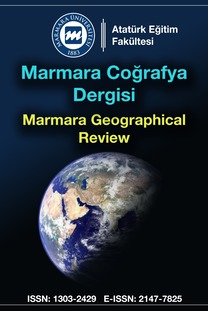Kentleşmenin büyükçekmece Gölü havzasındaki arazi kullanım değişimleri üzerindeki etkisinin zamansal analizi
Son 20 yılda nüfusu iki kat artan İstanbul, yurt genelinde gerek ticari gerekse yaşam standartlarının yüksekliği bakımından bir cazibe merkezi olarak kabul edilen ve halen yurt içi göçlerde liste başı olan Türkiye’nin en büyük anakentidir. Günümüzde 12,5 milyonun üzerinde bir nüfusun yaşadığı İstanbul’da bu hızlı nüfus artışının sonucu olarak çok sayıda düzenli konut ve sanayi alanının yanında, plansız kentleşmenin en çarpıcı örneklerine de rastlanılmaktadır. Kontrol altına alınamayan ve birçok noktada eş zamanlı olarak meydana gelen plansız yapılaşma uzun ve kısa vadelerde alt yapı sorunları, çevre kirliliği, ekolojik dengenin bozulması, düşük çevre kalitesi gibi problemleri de beraberinde getirmiştir. Bu duruma örnek teşkil eden alanlardan biri de, son 15 yıl içerisinde İstanbul’da en hızlı gelişen bölgelerden biri olan, Büyükçekmece Gölü Havzası’dır. İstanbul’un en önemli içme suyu havzalarından bir olan havza üzerinde son zamanlarda konut alanları başta olmak üzere sanayi ve ticaret alanları hızla gelişmektedir. Bu çalışmanın amacı da havzadaki arazi kullanımı değişimlerindeki şehirleşmenin etkisini tespit etmek ve bu içme suyu havzası üzerindeki şehirleşme tehdidini ortaya koymaktır. Bu bağlamda Büyükçekmece su havzası koruma kuşakları göz önüne alınarak 1987 ve 2007 yıllarına ait yüksek çözünürlüklü Landsat görüntüleri kullanılarak havzanın arazi kullanım alanları tespit edilmiş ve zamansal değişiklikler görsel ve istatistiksel olarak ortaya konmuştur.
(The temporal analysis of the effects of urbanization on the land use change in Buyukcekmece lake basin)
Istanbul which its population has doubled in the last a few decades, is the biggest city of Turkey drawing an important amount of migration and has placed at the middle of attention in terms of high life standards and trade in Turkey. Istanbul, with more than 12 million population at present (TÜİK: 12.573.836), along with its well developed settlement and industrial areas it also has the striking examples of unplanned urbanization as a result of high population increase rate. Uncontrolled growth of cities which has been faced simultaneously at the different parts of the country has resulted in various infrastructure problems, environmental pollution, damages in ecological equilibrium, and degradation of environmental quality. One of the most prominent examples of this situation is Buyukcekmece Basin facing rapid and excessive development in Istanbul. Buyukcekmece Lake which constitutes one of the most important drinking water resources of Istanbul is experiencing rapid growth of industrial and trade centers. The main purpose of this study is to investigate the effects of rapid urbanization on the land use variations in the study area and to indicate the threat of uncontrolled development on the Buyukcekmece Basin. In this context, the land use characteristics and the process of the land use changes in the study area will be examined regarding the Buyukcekmece Basin protection zones based on the high resolution satellite images belong to 1987 and 2007. At the end of the study, the temporal and spatial variations of the land use of the study area will be introduced.
___
Akgün H., 1996, Kentsel Gelişme Sürecinde Büyükçekmece. İstanbul Üniversitesi, Deniz Bilimleri ve İşletmeciliği Enstitüsü, Basılmamış Doktora Tezi, İstanbul.
Karakuyu, M., 2006, İstanbul’un Mekansal Gelişiminin Analizi. 4. Coğrafi Bilgi Sistemleri Bilişim Günleri Bildiriler Kitabı, İstanbul, 477-483.
Lillesand, T. M., Kiefer, R.W. Chipman, J.W., 2004, Remote Sensing and Image Interpretation. John Wiley & Sons, Inc., New York.
Maktav D., Erbek F. S., 2005 “Analysis of Urban Growth Using Multi Temporal Satellite Data in Istanbul” International Journal of Remote Sensing, sayı 26 (4), s. 797-810, Londra.
Richards, J., A., 1995, Remote sensing digital image analysis: An introduction. Springer-Verlag.
İSKİ Genel Müdürlüğü, 2010, www.iski.gov.tr, 03.03.2010. Devlet Su İşleri, 2011, http://www2.dsi.gov.tr/bolge/dsi14/isletme.htm, 15.06.2011.
